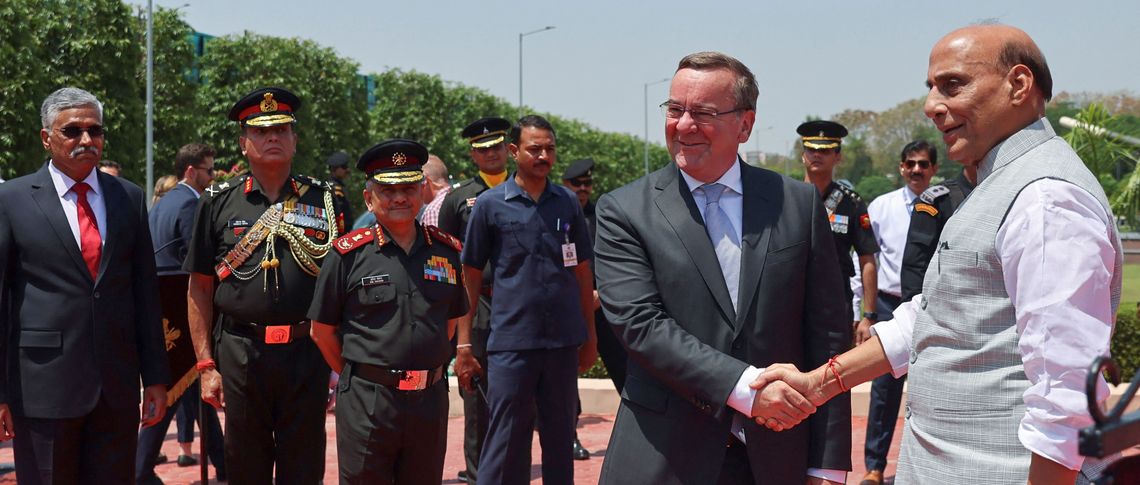German Defence Minister Boris Pistorius’s visit to New Delhi this week has featured talks with his Indian counterpart Rajnath Singh on strengthening defence industrial cooperation between the two countries. His visit also included a stop to Mumbai to sign an agreement with an Indian partner of Thyssenkrupp Marine Systems (TKMS) – the German company that has a bid for a submarine contract valued at $5.2 bn. The visit – a first by a German minister since 2015 – takes place against the backdrop of the Russia-Ukraine war, which has set off a series of disruptions to supply chains and future procurement decisions across many sectors, including defence, in Asia and Europe.
Russia has historically been India’s main defence partner, but since the Russian invasion of Ukraine, doubts over Russian capacities to keep production lines running for export surfaced. In 2022, this led India to double down on indigenization efforts, particularly on spares for Russian equipment. Since then, longer-term concerns – such as Russia’s growing proximity to China over the course of the war and its expected future security preoccupations in Europe – have also raised questions in New Delhi about the long-term reliability of the India-Russia defence relationship. Though India was already in the process of diversifying military suppliers (for different reasons), it is now compelled to do more – and on a quicker timeline.
An Indo-German defence partnership
For reasons including closer geopolitical alignment, India finds itself looking more toward the US and Europe as potential military suppliers, presenting an opportunity to countries such as Germany. The reason why this has become a moment to consider Germany is because of the country’s own re-think around arms exports policy and broader national security outlook – famously framed by Chancellor Olaf Scholz as a Zeitenwende, meaninga watershed moment – since February 2022. However, while external conditions seem favourable, there are other enabling factors that further show the potential for an Indo-German defence partnership.
A second factor that looms large in an early assessment of India-German defence relations is the ‘China question’.
A key issue is Germany’s national regulations governing defence supplies. This is especially important for a country like India that faces a serious territorial dispute with China, a stronger economic power, at one of its land borders. As such, India would be looking for mechanisms that would insulate any military equipment supply from policies or processes that could disrupt its flow. This aspect gets highlighted in the case of Germany, where an arms export law announced in 2021 is pending and traditionally has been favoured by the current Social Democratic party in power, as well as the Green party, one of its two coalition partners. This is being envisioned as an addition to the five existing laws on defence exports and two binding political guidelines (the latter accommodates the values-oriented component of German foreign policy), which are already viewed as onerous conditions by Indian defence experts. There seems to be some understanding of Indian hesitations on this front, given recent news reports which allude to the coalition government ‘informally’ relaxing the arms export guidelines for India in February this year by allowing exports of ‘some military equipment’.
A second factor that looms large in an early assessment of India-German defence relations is the ‘China question’. The extent of Germany’s trade dependence on China is a factor that would matter to an Indian assessment since it raises the risk of defence supply arrangements being threatened in the event of conflict between India and China – a spectre of risk that is now very likely going to be factored into future defence partnership assessments with Russia. A certain reliability of supply – especially in conflict situations – are qualities of India’s newer defence partners such as Israel and France, which have been widely spoken about, and could be understood as part of the Indian defence calculation.
Support for local manufacturing
A highly publicised set of government guidelines announced for Indian defence procurements since 2020 has focused on the indigenisation of certain defence parts and equipment. These guidelines are a mix of import bans on bigger weapons systems and platforms, where India already holds manufacturing capacity, and bans on smaller components and subsystems that could easily be manufactured in India. Though framed as policy incentives for India’s private sector within the defence and ancillary industries, they are also a signal to foreign defence suppliers to establish manufacturing capacities in India in support of indigenous capacity. In practice, what these collaborations could look like would vary – from an ancillary manufacturing contribution to joint production of more complex system parts, licensed manufacture of the entire system, or licensed manufacture including the transfer of technology.
India is likely aiming for all of these variations of collaboration with foreign manufacturers, not least to insert itself in a more substantial way into the global defence supply chain of which it is one of the largest buyers. In recent years, India has increased the Foreign Direct Investment cap in defence to encourage private and foreign company collaborations to manufacture locally (the cap was raised from 49 to 74 per cent through the automatic route and up to 100 per cent through the government route). The country has also been bringing foreign companies in touch with domestic defence start-ups – such as at the recently concluded Aeroshow in Bangalore – and has seized this period of ongoing military supply disruptions for countries dependent on Russia to project its future ambitions as a defence exporter. This ambition, in particular, is likely to depend on the kind of collaborations India is able to strike up with future defence partners – with collaborations at the higher end of the value chain for joint manufacture of systems with technology transfer being the preferred option.
India’s low R&D (research and development) budget for defence and subsequent lack of innovation in Indian public sector defence manufacturing would also make this an imperative. Negotiating technology transfers has always been a tricky gambit, and even Russia – India’s defence mainstay – has not managed to fully satisfy Indian expectations, though they have come the closest of all defence partners to date.
The Indo-Russian defence relationship
If one looks at the Indo-Russian defence relationship, there are a number of reasons that have so far privileged Russian defence cooperation in the Indian calculus. Amongst these is that Russia has been willing to work with India on strategic programs in which no other country has expressed comparable interest. Since the 1970s, Russia (then the Soviet Union) has co-developed and shared sensitive defence technologies with India, such as the technology that led to the development of India’s first indigenous nuclear-powered submarine, as well as scientific knowledge that helped India develop its own space program. Many of these critical technology transfers happened against a backdrop of active US opposition and sanctions, which India absorbed as reactions to the idea of expanding strategic capabilities beyond an ideologically-aligned in-group.
Even after the Cold War’s ideological affinities dimmed, Russia and India have broadly shared points of convergence on many key political and strategic issues in Asia, which has helped in keeping this a close relationship working towards similar objectives. The extent to which the consequences of the Ukraine war change this view of Asia and Eurasia is yet to be seen, but the takeaway here is for countries who are looking at India as a strategic partner in protecting shared interests – for example, in the Indo-Pacific. For these countries, periodically engaging in an exchange of views to better understand areas of strategic congruence would help build a defence relationship that would answer both immediate material needs and shared longer-term objectives.
India clearly realises its position of strength in Asia as a counter-force to a China that holds hegemonic aspirations for the region, and it is shaping the terms of its engagements with others accordingly.
Russia has also been early to engage India’s ambition to set up indigenous military manufacturing capability, starting already in the 1960s. The most successful joint venture between the two has been the joint development of the BrahMos cruise missile, a project initiated in 1998 with technology transfer that is often referred to as the most successful collaboration between the two countries to date. The transfer of technology related to the canisterisation of missiles enabled India to make its indigenous Agni-I missile. Moreover, the BrahMos cruise missile landed its first export order in January 2022, worth $ 374 million, with prospects for sale to others in Asia looking for effective, yet comparatively inexpensive anti-ship missile defences.
The relatively lower purchase price of Russian equipment for India is another well-acknowledged fact that has privileged Russian systems in the Indian calculus. Though ‘friendship prices’ of the Soviet era have long since lapsed into prices more reflective of life-cycle maintenance costs of the equipment and other factors, it still remains less expensive than most Western equipment.
The February 2023 visit of Chancellor Scholz to India included discussions on military sales, particularly on the §5.2 bn deal with India to jointly build six conventional submarines – a bid that other Western countries ruled out of for reasons of technology transfer requirements. In these times of high-stakes geopolitics, the cost-benefit calculation of deepening the trade and military dimensions of a relationship are bound to be marked with trade-offs that were not up for discussion earlier. India (in the buyer’s position) clearly realises its position of strength in Asia as a counter-force to a China that holds hegemonic aspirations for the region, and it is shaping the terms of its engagements with others accordingly. India will demand that prospective defence partners satisfy national security risk perceptions and also aid in domestic targets for industrial growth while comparing them against Russian offerings for the same. The strategic value of weapons purchases will also be an important factor given unsettled equations with China at its northern borders. At the same time, these demands are bound to be tempered with greater awareness of the risk profile that military dependence on a weaker Russia will entail. It is up to interested countries to find the appropriate entry point into this arena.






